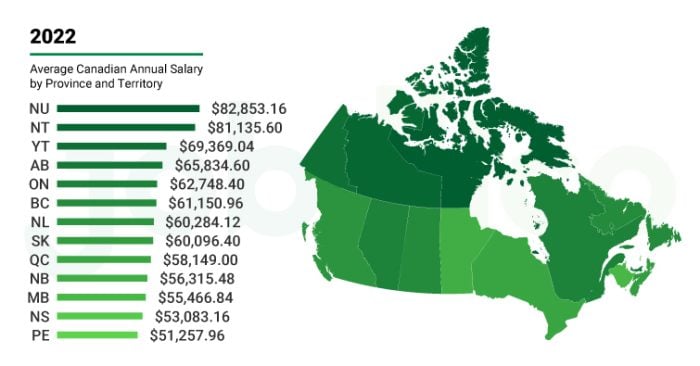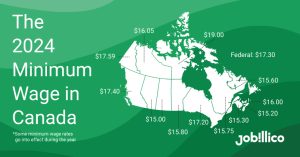The Average Canadian Salary in 2022
 Publié le 21 December 2022
Publié le 21 December 2022
What is the average Canadian salary in 2022? Job seekers, employers and organizations should be aware of the latest salary statistics across the country, especially in a competitive job market.
Money is on everyone’s mind. This includes job seekers trying to find roles that properly value their skills, and employers looking to find qualified employees. Statistics Canada has released a collection of data which highlights salary and wage growth in multiple job sectors and the different provinces across the country.
Reviewing and analyzing this data provides answers to some important questions about the current state of the economy. Knowing the average Canadian salary in 2022 will allow people to better understand their job role, their industry and what it means for their career future.
For young people entering the workforce and for those dissatisfied with their role and considering a career change into a new field, this information can help ensure that they will be fairly compensated for the valuable skills and experience they bring into the workplace.
What Is The Average Canadian Salary in 2022?
As of September 2022, the average Canadian salary in 2022 was $1,175.37 per week or $61,119.24 per year for full-time employees. When looking at the breakdown province by province, the overall trend is positive, with people in each province earning more money than they had in 2021.
There have been minimum wage increases in multiple provinces, including Ontario, Quebec,, Manitoba, Saskatchewan, and Newfoundland and Labrador. Of course, geographic location and job sector has a significant impact on the total salary earned and requires further exploration.
Average Canadian Annual Salary by Province and Territory*

- British Columbia – $61,150.96 (+3.5%)
- Alberta – $65,834.60 (+2.6%)
- Saskatchewan – $60,096.40 (+3.7%)
- Manitoba – $55,466.84 (+3.7%)
- Ontario – $62,748.40 (+3.4%)
- Quebec – $58,149.00 (+4.4%)
- New Brunswick – $56,315.48 (+6.2%)
- Nova Scotia – $53,083.16 (+4.2%)
- PEI – $51,257.96 (+3.1%)
- Newfoundland – $60,284.12 (+2.5%)
- Yukon – $69,369.04 (+0.5%)
- Northwest Territories – $81,135.60 (+0.9%)
- Nunavut – $82,853.16 (+7.2%)
*Data from September 2022
While the average Canadian salary in 2022 has increased in every province, the actual amount earned can differ widely from province to province. The average annual salary remains high in British Columbia, Alberta and Ontario, but also is still lower in three of the four Maritime provinces.
Of interesting note is that the average annual salary in Saskatchewan and Newfoundland and Labrador has exceeded those found in Quebec. This was true in 2021, and this year these salaries are almost on par with those found in Ontario. Considering the much lower costs of living in Saskatchewan and Newfoundland and Labrador, this will make these areas more popular with job seekers looking to get the most for their money.
Like 2021, 2020 and 2019, the highest average Canadian salary can be found in the Yukon, Northwest Territories and Nunavut. These areas of Canada have a large stake in the energy, mining and natural resource sectors, and proves that these industries continue to have significant impact on the overall economy of Canada.
The Provinces/Territories with the Highest Rate of Salary Growth
While salaries have increased in every province and territory, it has not occurred by the same amount. In 2022, the highest increase in the average annual salary occurred in Nunavut, with a 7.2% raise. New Brunswick, which historically has a lower average annual salary, experienced the second largest increase at 6.2%. The provinces of Quebec and Nova Scotia experienced similar increases of 4.4% and 4.2%, respectively. Saskatchewan and Manitoba had identical increases of 3.7% to their average annual salary in 2022.
- Nunavut +7.2%
- New Brunswick +6.2%
- Quebec +4.4%
- Nova Scotia +4.2%
- Saskatchewan/Manitoba +3.7%
The Provinces/Territories with the Lowest Rate of Salary Growth
The average Canadian salary in 2022 did not decrease in any province or territory. While this is certainly good news, the reality is that with the high rate of inflation, workers in almost every province experienced a net decrease in the value of their salary. Prince Edward Island and the Yukon, two areas that experienced the highest salary growth in 2021, now found themselves with some of the lowest salary increases in the country. Except PEI, the remaining areas of the country with the lowest salary increases in 2022 still have the highest average annual salaries.
- Prince Edward Island – +3.1
- Alberta – +2.6
- Newfoundland and Labrador – +2.5
- Northwest Territories – +0.9
- Yukon – +0.5
Average Annual Canadian Salary by Job Sector*
- Accommodation and Food Services – $24,351.60 (+1.3%)
- Administrative and Support – $49,550.28 (-1.1%)
- Arts, Entertainment and Recreation – $37,910.08 (+0.6%)
- Construction – $75,743.72 (+6.1%)
- Education – $59,540.52 (-3.6%)
- Finance and Insurance – $89,654.24 (+18.0%)
- Forestry and Logging – $73,402.68 (+9.5%)
- Health Care and Social Assistance – $52,866.84 (+3.1%)
- Information and Culture Industries – $84,320.08 (-2.2%)
- Management of Companies and Enterprises – $77,670.84 (-6.1%)
- Manufacturing – $64,922.00 (+3.8%)
- Mining, Oil and Gas Extraction – $119,830.88 (+2.8%)
- Professional, Scientific and Technical Services – $85,272.72 (+6.2%)
- Public Administration – $79,673.88 (+3.8%)
- Real Estate (Rental/Leasing) – $62,613.20 (-1.1%)
- Retail – $36,645.96 (+6.3%)
- Transportation and Warehousing – $63,780.60 (+3.3%)
- Utilities – $100,233.12 (+2.8%)
- Wholesale Trade – $72,771.40 (+3.4%)
*Data from September 2022
Canadian Industries with the Most Growth in 2022
The average Canadian salary in 2022 has increased, but this growth is not identical across every job sector. There are certain industries which have experienced far more salary growth than others this year, compared to others which have only had marginal increases. By knowing the job sectors and industries experiencing the high level of annual average salary growth, job seekers will know where their skills will be valued and rewarded in the long term.
- Finance and Insurance – +18.0%
- Forestry and Logging – +9.5%
- Retail – +6.3%
- Professional, Scientific and Technical Services – +6.2%
- Construction – +6.1%
Only one industry in Canada has experienced average annual salary growth of more than 10%, compared to three sectors in 2021. Except for two sectors — Finance and Insurance at 18% and Forestry and Logging at 9.5% — all job sectors experienced growth of less than 6.5%.
While the Finance and Forestry industries have experience high growth in years past, the fact that the Retail sector has experienced the third highest level of average annual salary growth, which can be seen as a result of the lifting of pandemic-mandates throughout the country early in the year.
Other than Retail, all the job sectors with the highest average annual salary growth in 2022 require specialized skills and knowledge. This highlights the impact that learning job-related skill sets and meeting specific requirements can have for those looking for a financially rewarding career.
Canadian Industries Where the Average Annual Salary Has Declined
While the average Canadian salary in 2022 has increased, this is not the case in all sectors. There are five job sectors that have experienced a decrease in the average annual salary over the course of this year.
- Administrative and Support – -1.1%
- Real Estate (Rental/Leasing) – -1.1%
- Information and Culture Industries – -2.2%
- Education – -3.6%
- Management of Companies and Enterprises – -6.1%
Perhaps the biggest surprise is that those working in the Real Estate industry have experienced a salary decrease of –1.1%. Employees in this sector have previously been in the top five for salary increases. This is a strong sign that the Canadian real estate market is hitting a rough patch, causing headaches for everyone involved. It is still too soon to tell if this will lead to the long-feared burst of the Canadian real estate bubble.
The sector with the biggest decline in the average annual salary is Management of Companies and Entreprises at –6.1%. While this is a considerable number, it should be noted that the salary for this sector is $77,670.84 per year. This means that it is still one of the highest earning job sectors in the country.
The Canadian Job Sectors with the Highest Average Annual Salary
- Mining, Oil and Gas Extraction – $119,830.88
- Utilities – $100,233.12
- Finance and Insurance – $89,654.24
- Professional, Scientific and Technical Services – $85,272.72
- Information and Culture Industries – $84,320.08
As in 2021 and 2020, most job sectors with the highest average annual salary are directly related to energy and natural resources. This is exemplified by the fact that the Mining, Oil and Gas Extraction and Utilities sectors are the only ones with an average annual salary of more than $100,000 in 2022.
The Professional, Scientific and Technical Services sector and Information and Culture Industries sector continue to offer high average annual salaries after continued growth in the past 2 years. Given the specific skills required for employees in these industries, they are willing to give strong compensation to qualified workers.
The Canadian Job Sectors with the Lowest Average Annual Salary
- Health Care and Social Assistance – $52,866.84
- Administrative and Support – $49,550.28
- Arts, Entertainment and Recreation – $37,910.08
- Retail – $36,645.96
- Accommodation and Food Services – $24,351.60
There are four job sectors where the average Canadian salary in 2022 is below $50,000 per year, while in 2021 there were three job sectors at this wage rate. The salary in the Administrative and Support sector has dropped to $49,550.28 in 2022. Of the five lowest earning job sectors, Health Care and Social Assistance employees are the only ones earning more than $50,000 in 2022.
The lowest annual salaries in Canada continue to be found in the Arts, Entertainment and Recreation, Retail, and Accommodation and Food Services. This is identical to 2021 and 2020. Even though the Retail sector has experienced some of the highest increases to their highest average salaries, it remains the second lowest in the entire country. People working in these sectors continue to face significant challenges and risks in return for low compensation and will require continued support in the coming year
The Economic Challenges Ahead
The data released by Statistics Canada shows that the average Canadian salary in 2022 has increased, which is good news for many working professionals across the country. There are industries that offer high compensation for both existing employees on their career path and qualified job seekers with specific skillsets.
However, certain job sectors have experienced salary decreases. Inflation continues to affect all workers, reducing their buying power in the face of increased living costs. In the face of many predictions of a recession in 2023, it’s clear that there are challenges ahead for all working professionals regardless of their average annual salary in the coming year.






